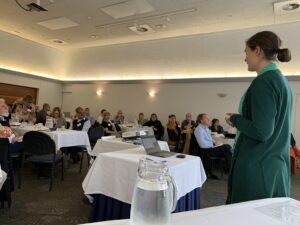Better Border Biosecurity (B3) project leaders shared details of their new research projects at the first face-to-face Science Partnership Forum (SPF) since COVID. The meeting was held in Wellington in October.
The recent SPF was also a chance for Biosecurity NZ Chief Biosecurity Officer Stu Hutchings and Ministry for Primary Industries Special Advisor – Māori Capacity Eden Skipper to share details of work being done to refresh the biosecurity system’s strategic direction. Building on Biosecurity 2025, the new strategic direction proposes six strategic priorities or ‘pou’ for the biosecurity system, with a new vision and mission. See the pou and give feedback.
Stu says the B3 forum was a great opportunity to share with researchers the refreshed biosecurity system strategic framework, aimed at ensuring Aotearoa New Zealand continues to achieve its biosecurity outcomes and aspirations. Stu says it was also good to get more details on the newly funded B3 research projects.
B3 Pourangahau Alby Marsh says Stu and Eden’s korero was very timely as B3 is also developing its Māori strategy. “As both strategies start to form this will be a great opportunity to have alignment in areas of commonality such as embedding Tiriti principles into our new and expanding partnerships and working environment. It is refreshing to see the emergence of integration and adoption of Te Tiriti in both strategies.”
B3 Director Dr David Teulon says this year was the largest funding allocation for more than five years. In June a total of $4 million in research funding was allocated to new plant biosecurity-related science projects.
“Researchers have worked hard with our partners and stakeholders, such as MPI, DOC, EPA, industry and iwi, to co-develop projects that meet their needs. So it was exciting for these researchers to share more details of these new projects and to answer questions with many of the stakeholders present. Projects include exploring Māori and pakeha concepts of biocontrol biosafety, eDNA for surveillance, accelerated plant ageing to lessen time spent in post-entry quarantine, and predicting the spillover over of pests and pathogens into natural ecosystems.”
The new projects are:
- Testing the toolbox: reducing uncertainty around non-target impacts (Project leader: Jacqui Todd)
- He waka hourua: Mātauranga and western science navigate a safe course for future biocontrol (Project leader: Waipaina Awarau-Morris)
- New risk assessment and detection tools for cereal and grass pathogens on the seed import pathway ((Project leader: Soonie Chng)
- Predicting the spillover of pests and pathogens into natural ecosystems (Project leader: Darren Ward)
- Development of the Integrated Biosecurity Risk Assessment Model (IBRAM) for pathogens (Project leader: Nari.Williams)
- Rapid screening method for optimising commodity treatments (Project leader: Kambiz Esfandi)
- De-risking the plant tissue culture pathway (Project leader: Hayley Ridgeway)
- Accelerated ageing of plants to shorten post-entry quarantine testing period (Project leader: Rebekah Frampton)
- The risk of egg diapause on pathways to New Zealand (Project leader: Jessica Vereijssen)
- Using images and deep learning for the identification of high-risk insect species (Project leader: Darren Ward)
- Metatranscriptomics informing the relevance of pathogen disease biomarkers in plants (Project leader: Sandra Visnovsky)
- Beyond soil-baiting: toward application of an eRNA diagnostic tool for Phytophthora (Project leader: Darryl Herron)
- Expanding our eradication toolbox: is biocontrol a feasible tool to incorporate in a response? (Project leader: Rachael Horner)
- eDNA for terrestrial biosecurity monitoring (Project leader: Andrew Cridge)
- Kaitiakitanga and Mātauranga Māori as a response to biosecurity threats (Project leader: Waipaina Awarau-Morris)

Project Leader Rachael Horner shares details of her project: Expanding our eradication toolbox: is biocontrol a feasible tool to incorporate in a response?
